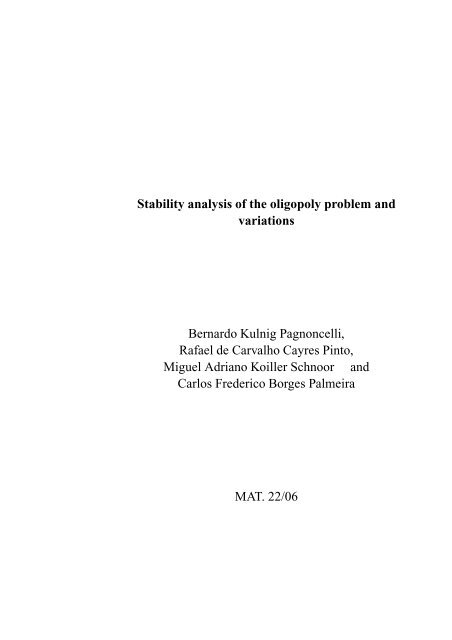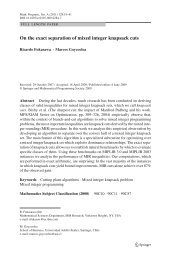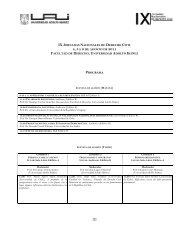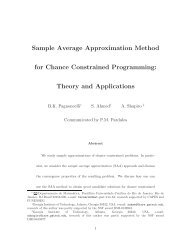Stability analysis of the oligopoly problem and variations Bernardo ...
Stability analysis of the oligopoly problem and variations Bernardo ...
Stability analysis of the oligopoly problem and variations Bernardo ...
Create successful ePaper yourself
Turn your PDF publications into a flip-book with our unique Google optimized e-Paper software.
<strong>Stability</strong> <strong>analysis</strong> <strong>of</strong> <strong>the</strong> <strong>oligopoly</strong> <strong>problem</strong> <strong>and</strong><br />
<strong>variations</strong><br />
<strong>Bernardo</strong> Kulnig Pagnoncelli,<br />
Rafael de Carvalho Cayres Pinto,<br />
Miguel Adriano Koiller Schnoor <strong>and</strong><br />
Carlos Frederico Borges Palmeira<br />
MAT. 22/06
<strong>Stability</strong> <strong>analysis</strong> <strong>of</strong> <strong>the</strong> <strong>oligopoly</strong> <strong>problem</strong> <strong>and</strong> <strong>variations</strong><br />
BERNARDO KULNIG PAGNONCELLI 1 , RAFAEL DE CARVALHO CAYRES PINTO 2 ,<br />
MIGUEL ADRIANO KOILLER SCHNOOR 1 AND CARLOS FREDERICO BORGES PALMEIRA 1<br />
1 Department <strong>of</strong> Ma<strong>the</strong>matics — Pontifícia Universidade Católica — Rio de Janeiro — Brazil<br />
2 Department <strong>of</strong> Economics — Pontifícia Universidade Católica — Rio de Janeiro — Brazil<br />
bernardo@mat.puc-rio.br. cayres@gmail.com. miguel@mat.puc-rio.br.<br />
fredpalm@mat.puc-rio.br.<br />
Abstract. In this paper we study <strong>the</strong> dynamical formulation <strong>of</strong> <strong>the</strong> n-firm Cournot <strong>oligopoly</strong> model <strong>and</strong> <strong>variations</strong>.<br />
We consider both discrete <strong>and</strong> continuous cases <strong>and</strong> discuss its stability as well as its long-term behavior. As <strong>the</strong>se<br />
resulting models are linear, we propose <strong>the</strong> use <strong>of</strong> techniques from linear algebra such as Shermann-Morrison’s<br />
formula <strong>and</strong> Sylvester’s Law <strong>of</strong> Inertia to deal with <strong>the</strong>m. We describe an algorithm to approximate <strong>the</strong> eigenvalues<br />
<strong>and</strong> eigenvectors associated to <strong>the</strong> systems <strong>and</strong> illustrates <strong>the</strong> techniques with a simple example.<br />
Keywords: <strong>oligopoly</strong> <strong>problem</strong>. eigenvalues. Shermann-Morrison formula.<br />
1 Introduction<br />
In this work we apply known techniques <strong>of</strong> eigenvalue <strong>and</strong> eigenvector calculation to <strong>the</strong> Cournot <strong>oligopoly</strong> model. Our<br />
main goal is to study <strong>the</strong> general n-firm case <strong>and</strong> to provide efficient numerical methods to approximate <strong>the</strong> solution <strong>of</strong> <strong>the</strong><br />
resulting systems. O<strong>the</strong>r authors have already concerned about this more general setting. In [4], Theocharis gives <strong>the</strong> long<br />
term behavior <strong>of</strong> <strong>the</strong> dynamic Cournot model for a simple case, with an arbitrary number <strong>of</strong> firms. His conclusion is that for<br />
more than 3 firms <strong>the</strong> solution is always unstable. Fisher (see [2]) considered a wider class <strong>of</strong> models, which incorporates<br />
increasing marginal costs, <strong>and</strong> extends Theocharis results for <strong>the</strong> n firm model. He also provided sufficient conditions on <strong>the</strong><br />
parameters <strong>of</strong> <strong>the</strong> model in order to guarantee <strong>the</strong> stability <strong>of</strong> <strong>the</strong> system.<br />
In <strong>the</strong> next section we briefly describe Cournot’s approach to <strong>the</strong> <strong>problem</strong> <strong>and</strong> derive <strong>the</strong> response curves for each firm. In<br />
section 3 we introduce time in <strong>the</strong> model in both discrete <strong>and</strong> continuous settings. Variations <strong>of</strong> <strong>the</strong> model such as quadratic<br />
production cost are also described. In section 4 we start with a simple case where an explicit answer is obtained, similar to [4].<br />
Fur<strong>the</strong>r, we introduce <strong>the</strong> ma<strong>the</strong>matical formalism <strong>and</strong> necessary techniques to study stability <strong>and</strong> long-term behavior <strong>of</strong> <strong>the</strong>se<br />
models. In section 5 we exemplify one <strong>of</strong> <strong>the</strong> techniques in a simple example <strong>and</strong> analyse its computational performance.<br />
2 The classical Cournot model<br />
The Cournot <strong>oligopoly</strong> model has been extensively studied. It is a model that considers n firms producing <strong>the</strong> same<br />
product competing for <strong>the</strong> market. The firms decide simultaneously <strong>the</strong> output <strong>and</strong> <strong>the</strong>y all sell <strong>the</strong>ir product at <strong>the</strong> market<br />
clearing price. According to [5], <strong>the</strong> equations that define <strong>the</strong> model are<br />
p = K − Q<br />
n∑<br />
Q =<br />
i=1<br />
q i<br />
C i = k i q i , i = 1, . . .,n,<br />
where p is <strong>the</strong> common selling price, K is an arbitrary constant, q i is <strong>the</strong> output <strong>of</strong> firm i, Q is <strong>the</strong> total amount <strong>of</strong> <strong>the</strong> product<br />
available in <strong>the</strong> market <strong>and</strong> C i is <strong>the</strong> cost <strong>of</strong> production <strong>of</strong> firm i. One can define <strong>the</strong> production cost as any increasing<br />
function f(q i ), such as q 2 i or arctan(q i) for example. We start using <strong>the</strong> linear function f(q i ) = k i q i <strong>and</strong> later we consider<br />
Preprint MAT. 22/06, communicated on September 25 th , 2006 to <strong>the</strong> Department <strong>of</strong> Ma<strong>the</strong>matics, Pontifícia Universidade Católica — Rio de Janeiro,<br />
Brazil.
B. K. Pagnoncelli, R.C.C. Cayres, M.A.K. Schnoor <strong>and</strong> C.F.B. Palmeira 2<br />
<strong>the</strong> quadratic case. Note that <strong>the</strong> price equation is st<strong>and</strong>ard in supply dem<strong>and</strong> models. The total revenue for each firm is pq i<br />
<strong>and</strong> <strong>the</strong> pr<strong>of</strong>it π i is given by<br />
π i = (K − Q)q i − k i q i . (1)<br />
We define <strong>the</strong> Cournot equilibrium as <strong>the</strong> output level <strong>of</strong> each firm that maximizes its pr<strong>of</strong>it given <strong>the</strong> output <strong>of</strong> all o<strong>the</strong>r<br />
firms. In order to obtain <strong>the</strong>se optimal quantities one must obtain <strong>the</strong> critical points <strong>of</strong> (1):<br />
⎛ ⎞<br />
∂π i<br />
n∑<br />
= ⎝K − q j<br />
⎠ − q i − k i = 0<br />
∂q i<br />
j=1<br />
for each i. Solving for q i we obtain<br />
⎛<br />
q i = 1 ⎝K − k i − ∑<br />
2<br />
j,j≠i<br />
q j<br />
⎞<br />
⎠ , ı = 1, . . .,n. (2)<br />
Each <strong>of</strong> <strong>the</strong>se equations represent a hyperplane in <strong>the</strong> n-dimensional space. The Cournot solution <strong>of</strong> <strong>the</strong> system is <strong>the</strong><br />
intersection point q ∗ = (q ∗ 1 , q∗ 2 , . . . , q∗ n ).<br />
Let us take a closer look at <strong>the</strong> Cournot equilibrium. It is an equilibrium in <strong>the</strong> sense that no firm would change its output<br />
knowing that its competitors will choose <strong>the</strong> prescribed output. This means that <strong>the</strong> market will sustain <strong>the</strong> equilibrium output<br />
levels indefinitely. The weakness <strong>of</strong> this equilibrium concept is that it does not tell us what happens if different output levels<br />
are observed. In <strong>the</strong> next section we will show how to introduce periods <strong>of</strong> time in <strong>the</strong> model in order to study <strong>the</strong> evolution<br />
<strong>of</strong> <strong>the</strong> system <strong>and</strong> its long term behavior given arbitrary initial output levels.<br />
3 Dynamic models<br />
In this section we describe <strong>the</strong> <strong>variations</strong> <strong>of</strong> <strong>the</strong> Cournot model based on [5]. There are two very different classes <strong>of</strong><br />
dynamical models we will consider: discrete <strong>and</strong> continuous. These classes are defined by <strong>the</strong> way we model time, which<br />
can be counted in discrete periods or continuously. We first consider discrete models.<br />
Under <strong>the</strong> discrete case we still have modelling issues. We have to specify in <strong>the</strong> model how future outputs depend on<br />
previous ones. In our formulation firms adjust <strong>the</strong>ir outputs using only o<strong>the</strong>r firms’ output levels in <strong>the</strong> immediately previous<br />
period. Inspired by formula (2), <strong>the</strong> model can be written as<br />
⎛<br />
q i,t+1 = 1 ⎝K − k i − ∑<br />
2<br />
j,j≠i<br />
q j,t<br />
⎞<br />
⎠, i = 1, . . . , n. (3)<br />
We refer to this model by <strong>the</strong> triplet (D, PM, L), where D st<strong>and</strong>s for discrete, PM for pr<strong>of</strong>it maximization <strong>and</strong> L for linear<br />
costs. This model can be written in <strong>the</strong> form<br />
q t+1 = Aq t + b, (4)<br />
where q t = (q 1,t , . . .,q n,t ), A is a n × n matrix <strong>and</strong> b is a n-dimensional vector. Note that this is a system <strong>of</strong> n difference<br />
equations. It is easily seen that <strong>the</strong> matrix A is given by<br />
⎛<br />
⎞<br />
0 −1/2 · · · −1/2<br />
−1/2 0 · · · −1/2<br />
A = ⎜<br />
⎝<br />
.<br />
. . ..<br />
⎟<br />
. ⎠ . (5)<br />
−1/2 −1/2 · · · 0<br />
Ano<strong>the</strong>r possibility is to diminish <strong>the</strong> discrepancy between <strong>the</strong> last output <strong>and</strong> <strong>the</strong> desired level (prescribed by formula<br />
(2))in <strong>the</strong> actual period:<br />
q i,t+1 − q i,t = α i (x i,t − q i,t ), 0 < α i ≤ 1, i = 1, . . . , n, (6)<br />
Preprint MAT. 22/06, communicated on September 25 th , 2006 to <strong>the</strong> Department <strong>of</strong> Ma<strong>the</strong>matics, Pontifícia Universidade Católica — Rio de Janeiro,<br />
Brazil.
3 The <strong>oligopoly</strong> <strong>problem</strong><br />
where x i,t = 1 2 (K − k i − ∑ j,j≠i q j,t). Notice that this model can be seen as a generalization <strong>of</strong> <strong>the</strong> previous one letting<br />
α = 1. We refer to this model as (D,DD,L) 1 . This system can also be written in form (4).<br />
In addition, we can consider quadratic costs instead <strong>of</strong> linear ones, that is, C i = k i qi 2 . This gives us two new models:<br />
(D,PM,Q) 2 <strong>and</strong> (D,DD,Q). Despite <strong>the</strong> presence <strong>of</strong> a quadratic term one can verify that both models can be written as in<br />
equation (4).<br />
The o<strong>the</strong>r class <strong>of</strong> models considers continuous time. In this context we clearly cannot consider instantaneous adjustment.<br />
The first model (C,L) is constructed based on its discrete counterpart, but instead <strong>of</strong> difference equations we have a system<br />
<strong>of</strong> differential equations:<br />
dq i (t)<br />
= α i (x i (t) − q i (t)), 0 < α i ≤ 1, i = 1, . . .,n,<br />
dt<br />
where q i (t) is <strong>the</strong> output at time t <strong>and</strong> x(t) is <strong>the</strong> continuous analog <strong>of</strong> Cournot solution in (2). The model can be written in<br />
<strong>the</strong> following general form:<br />
˙q = Aq + b, (7)<br />
where <strong>the</strong> dot denotes derivative with respect to t, A is again a n × n matrix <strong>and</strong> b is a n-dimensional vector. In <strong>the</strong> case<br />
(C,L) <strong>the</strong> matrix A is given by<br />
⎛<br />
⎞<br />
−α 1 −α 1 /2 · · · −α 1 /2<br />
−α 2 /2 −α 2 · · · −α 2 /2<br />
A = ⎜ . .<br />
⎝<br />
.<br />
. . ..<br />
. ⎟<br />
. ⎠ . (8)<br />
−α n /2 −α n /2 · · · −α n<br />
All models we have shown lead to linear systems <strong>of</strong> equations <strong>and</strong> so, to study <strong>the</strong>ir stability, we have to find <strong>the</strong> spectrum,<br />
that is, <strong>the</strong> set <strong>of</strong> eigenvalues <strong>of</strong> <strong>the</strong> many matrices related to each <strong>of</strong> those systems. The presence <strong>of</strong> <strong>the</strong> vector b in <strong>the</strong> models<br />
does not influence <strong>the</strong> behavior <strong>of</strong> <strong>the</strong> system since one can get rid <strong>of</strong> it by a linear change <strong>of</strong> variables. We will get into this<br />
<strong>analysis</strong> in <strong>the</strong> next section.<br />
4 <strong>Stability</strong> <strong>analysis</strong><br />
As we mentioned in <strong>the</strong> previous section, to obtain explicit solutions <strong>of</strong> <strong>the</strong> systems <strong>and</strong> to underst<strong>and</strong> its long-term<br />
behavior all we need is to find <strong>the</strong> eigenvalues <strong>of</strong> <strong>the</strong> corresponding matrices. Moreover, certain conditions on <strong>the</strong> eigenvalues<br />
describe if <strong>the</strong> system will converge to <strong>the</strong> equilibrium or not. Ma<strong>the</strong>matically, when we have a system <strong>of</strong> difference equations<br />
this condition is that all eigenvalues are inside <strong>the</strong> unitary disk (Figure 1) while in <strong>the</strong> continuous case one must have all <strong>the</strong><br />
eigenvalues with negative real part (Figure 2). In this way, <strong>the</strong> <strong>problem</strong> reduces to efficient methods <strong>of</strong> calculating eigenvalues<br />
<strong>and</strong> that is <strong>the</strong> direction we will take now.<br />
i<br />
−1<br />
0<br />
1<br />
0<br />
−i<br />
Figure 1: stability region for <strong>the</strong> discrete case.<br />
Figure 2: stability region for <strong>the</strong> continuous case.<br />
Let us first analyse <strong>the</strong> (D,PM,L) case. A very similar model was studied in [4], so we just outline <strong>the</strong> eigenvalue<br />
calculation. Notice that <strong>the</strong> matrix A <strong>of</strong> this model (see (5)) can be decomposed in <strong>the</strong> sum −1/2(U − I), where U is<br />
1 DD st<strong>and</strong>s for diminished discrepancy.<br />
2 Q st<strong>and</strong>s for quadratic.<br />
Preprint MAT. 22/06, communicated on September 25 th , 2006 to <strong>the</strong> Department <strong>of</strong> Ma<strong>the</strong>matics, Pontifícia Universidade Católica — Rio de Janeiro,<br />
Brazil.
B. K. Pagnoncelli, R.C.C. Cayres, M.A.K. Schnoor <strong>and</strong> C.F.B. Palmeira 4<br />
<strong>the</strong> matrix whose entries are equal to 1 <strong>and</strong> I is <strong>the</strong> n-dimensional identity matrix. Once we know <strong>the</strong> spectrum <strong>of</strong> U, we<br />
can easily find <strong>the</strong> spectrum σ(A) <strong>of</strong> A. If v is an eigenvector <strong>of</strong> U associated with <strong>the</strong> eigenvalue λ, we claim that v is an<br />
eigenvector <strong>of</strong> A with eigenvalue −1/2(λ − 1). The pro<strong>of</strong> is straightforward:<br />
−1/2(U − I)v = −1/2(Uv − Iv) = −1/2(λv − v) = −1/2(λ − 1)v. (9)<br />
The spectrum <strong>of</strong> <strong>the</strong> matrix U is elementary: first note that <strong>the</strong> matrix has rank 1 <strong>and</strong> <strong>the</strong>refore it has n −1 eigenvalues equals<br />
to zero. As <strong>the</strong> sum <strong>of</strong> <strong>the</strong> eigenvalues must be equal to <strong>the</strong> trace, we have that <strong>the</strong> missing eigenvalue is equal to n. Using<br />
<strong>the</strong> preceding calculation we conclude that σ(A) = {1/2, 1/2, . . ., (1 − n)/2}.<br />
The result obtained implies that <strong>the</strong> long-term behavior depends solely on <strong>the</strong> number n <strong>of</strong> firms. If n = 2 <strong>the</strong> system is<br />
asymptotically stable, that is, it converges to <strong>the</strong> Cournot equilibrium q ∗ . If n = 3 <strong>the</strong> system exhibits oscillatory behavior.<br />
Finally, if n ≥ 4 <strong>the</strong> system is unstable <strong>and</strong> <strong>the</strong> output levels become arbitrarily large in absolute value.<br />
The matrix <strong>of</strong> <strong>the</strong> (D,PM,L) case is simple <strong>and</strong> we were able to explicitly calculate its eigenvalues. More sophisticated<br />
linear algebra tools are needed to calculate <strong>the</strong> eigenvalues <strong>of</strong> o<strong>the</strong>r models’ matrices or at least to underst<strong>and</strong> <strong>the</strong> long term<br />
behavior <strong>of</strong> each system.<br />
(a) The signature <strong>of</strong> a matrix<br />
An important concept in linear algebra is <strong>the</strong> signature <strong>of</strong> a matrix. It is well suited for our purposes, specially in <strong>the</strong><br />
continuous case.<br />
Definition 1 (Signature <strong>of</strong> a matrix) Let A be a n × n symmetric matrix. Its signature Σ(A) is <strong>the</strong> triplet formed by <strong>the</strong> <strong>the</strong><br />
number <strong>of</strong> positive, negative <strong>and</strong> null eigenvalues <strong>of</strong> <strong>the</strong> matrix A.<br />
As an example note that <strong>the</strong> signature <strong>of</strong> <strong>the</strong> n-dimensional identity matrix is (n, 0, 0), where <strong>the</strong> first coordinate represents<br />
<strong>the</strong> number <strong>of</strong> positive eigenvalues, <strong>the</strong> second <strong>the</strong> number <strong>of</strong> negative ones <strong>and</strong> <strong>the</strong> third <strong>the</strong> number <strong>of</strong> eigenvalues equals<br />
to zero.<br />
We now state a classical <strong>the</strong>orem involving <strong>the</strong> signature <strong>of</strong> a matrix:<br />
Theorem 2 (Sylvester’s Law <strong>of</strong> Inertia) Let A be a n × n symmetric matrix <strong>and</strong> let C be a non-singular n × n matrix.<br />
Then Σ(A) = Σ(C T AC).<br />
For an outline <strong>of</strong> <strong>the</strong> pro<strong>of</strong> see ([6]). Remember from Figure 2 that <strong>the</strong> stability <strong>of</strong> a continuous model is determined by<br />
<strong>the</strong> sign <strong>of</strong> <strong>the</strong> real part <strong>of</strong> its eigenvalues. Even though <strong>the</strong> matrix <strong>of</strong> <strong>the</strong> (C,L) model is non-symmetric, we will see that<br />
its eigenvalues are real <strong>and</strong> <strong>the</strong>n we can use Sylvester’s Law to obtain its signature. We show how to proceed on a lowdimensional<br />
case only for clarity <strong>of</strong> exposition. One may directly extend <strong>the</strong> result for <strong>the</strong> general n ×n case. Thus, recalling<br />
<strong>the</strong> (C,L) matrix defined in (8), we have for n = 3<br />
⎛<br />
A = ⎝ −α ⎞<br />
1 −α 1 /2 −α 1 /2<br />
−α 2 /2 −α 2 −α 2 /2 ⎠.<br />
−α 3 /2 −α 3 /2 −α 3<br />
We note that studying Σ(A) is <strong>the</strong> same as studying <strong>the</strong> signature <strong>of</strong> B = −2A: a positive eigenvalue <strong>of</strong> B represents a<br />
negative eigenvalue <strong>of</strong> A <strong>and</strong> vice-versa. We can rewrite B as a product <strong>of</strong> simpler matrices:<br />
⎛<br />
B = ⎝ 2α ⎞ ⎛<br />
1 α 1 α 1<br />
α 2 2α 2 α 2<br />
⎠ = ⎝ 2α ⎞ ⎛<br />
⎞<br />
1 0 0 1 1/2 1/2<br />
0 2α 2 0 ⎠ ⎝ 1/2 1 1/2 ⎠<br />
α 3 α 3 2α 3 0 0 2α 3 1/2 1/2 1<br />
⎛ √ ⎞ ⎛ √ ⎞⎛<br />
⎞<br />
2α1<br />
√<br />
0 0 2α1<br />
√<br />
0 0 1 1/2 1/2<br />
= ⎝ 0 2α2<br />
√<br />
0 ⎠ ⎝ 0 2α2<br />
√<br />
0 ⎠⎝<br />
1/2 1 1/2 ⎠ .<br />
0 0 2α3 0 0 2α3 1/2 1/2 1<br />
Using that for any two matrices P, Q we have σ(PQ) = σ(QP), we see that<br />
⎛<br />
⎝<br />
√ ⎞⎛<br />
2α1<br />
√<br />
0 0<br />
0 2α2<br />
√<br />
0 ⎠⎝ 0 0 2α3<br />
1 1/2 1/2<br />
1/2 1 1/2<br />
1/2 1/2 1<br />
⎞⎛<br />
√ ⎞<br />
2α1<br />
√<br />
0 0<br />
⎠⎝<br />
0 2α2 0 ⎠<br />
√<br />
0 0 2α3<br />
Preprint MAT. 22/06, communicated on September 25 th , 2006 to <strong>the</strong> Department <strong>of</strong> Ma<strong>the</strong>matics, Pontifícia Universidade Católica — Rio de Janeiro,<br />
Brazil.
5 The <strong>oligopoly</strong> <strong>problem</strong><br />
has <strong>the</strong> same spectrum <strong>of</strong> B. As <strong>the</strong> second matrix in this product is symmetric, we can use 2 to conclude that<br />
⎛<br />
⎞<br />
1 1/2 1/2<br />
S = ⎝ 1/2 1 1/2 ⎠<br />
1/2 1/2 1<br />
has <strong>the</strong> same signature <strong>of</strong> B. This matrix can be written as S = 1/2(U) + 1/2I <strong>and</strong> its spectrum is σ(S) = {1/2, 1/2, 2},<br />
which can be easily calculated following <strong>the</strong> same steps as in <strong>the</strong> (D,PM,L) case. We observe that in <strong>the</strong> n-dimensional case<br />
we have σ(S) = {1/2, . . ., 1/2, (n + 1)/2}. Remembering that B = −2A, we see that Σ(A) = (0, 3, 0) <strong>and</strong> hence <strong>the</strong><br />
system is stable for any adjustment constants α i , i = 1 . . .3.<br />
We note that Sylvester’s Law <strong>of</strong> Inertia 2 is a limited tool in <strong>the</strong> sense that it does not explicitly calculate any eigenvalue<br />
<strong>of</strong> A. It solely gives us <strong>the</strong> signature <strong>of</strong> <strong>the</strong> matrix, which in <strong>the</strong> continuous case describes <strong>the</strong> stability, provided that <strong>the</strong><br />
eigenvalues <strong>of</strong> <strong>the</strong> intermediate matrix (in our example it was matrix S) can be computed.<br />
(b) Computing <strong>the</strong> eigenvalues explicitly<br />
Now we study ano<strong>the</strong>r classical method <strong>of</strong> linear algebra that will enable us to calculate <strong>the</strong> eigenvalues <strong>of</strong> <strong>the</strong> matrices<br />
involved in <strong>the</strong> models. The method was developed by Shermann <strong>and</strong> Morrison <strong>and</strong> it is a technique to solve linear systems<br />
<strong>of</strong> equations. A good reference for <strong>the</strong> method is [3].<br />
Suppose we have a linear system Ax = b where A = B + u ⊗ v, B is a matrix whose inverse can be easily computed <strong>and</strong><br />
⊗ denotes tensor product, defined by u ⊗ v = uv T , where v T is <strong>the</strong> transpose <strong>of</strong> <strong>the</strong> vector v .Denoting by 〈u, v〉 <strong>the</strong> inner<br />
product u T v, one can proceed as follows:<br />
Ax = b ⇔ (B + u ⊗ v)x = b ⇔ Bx + uv T x = b<br />
⇔ Bx + u〈v, x〉 = b ⇔ x + B −1 u〈v, x〉 = B −1 b, (10)<br />
where we pre-multiplied <strong>the</strong> last equality by B −1 . We consider x <strong>and</strong> 〈v, x〉 as two different terms <strong>and</strong> solve for 〈v, x〉. Then<br />
we take <strong>the</strong> inner product with v at both sides to get<br />
〈v, x〉 + 〈v, B −1 u〉〈v, x〉 = 〈v, B −1 b〉<br />
⇒ 〈v, x〉 = 〈v, B−1 b〉<br />
1 + 〈v, B −1 u〉 .<br />
Substituting 〈v, x〉 on <strong>the</strong> second equation <strong>of</strong> (10) we can write <strong>the</strong> solution as<br />
x = B −1 b − B−1 u〈v, B −1 b〉<br />
1 + 〈v, B −1 u〉 . (11)<br />
Recalling that <strong>the</strong> inverse matrix B can be easily computed, we have obtained a solution without inverting <strong>the</strong> original matrix<br />
A, which could be hard to calculate.<br />
We are going to apply this method to obtain a numerical scheme to find all <strong>the</strong> eigenvalues <strong>of</strong> (D,PM,Q)-matrix below:<br />
⎛<br />
⎞<br />
0 −β 1 · · · −β 1<br />
−β 2 0 · · · −β 2<br />
A = ⎜<br />
⎝<br />
.<br />
. . ..<br />
⎟<br />
. ⎠ , (12)<br />
−β n −β n · · · 0<br />
where β i = 1/(2 + 2k i ). As before we go through <strong>the</strong> 3 × 3 case. We start by decomposing A as follows:<br />
A =<br />
=<br />
⎛<br />
⎝ 0 −β ⎞ ⎛<br />
1 −β 1<br />
−β 2 0 −β 2<br />
⎠ = ⎝ β ⎞ ⎛<br />
1 0 0<br />
0 β 2 0 ⎠ ⎝ 0<br />
−β 3 −β 3 0 0 0 β 3<br />
⎛ √ ⎞⎛<br />
√ ⎞⎛<br />
β1<br />
√<br />
0 0 β1<br />
√<br />
0 0<br />
⎝ 0 β2<br />
√<br />
0 ⎠⎝<br />
0 β2 0 ⎠<br />
√<br />
0 0 β3 0 0 β3<br />
⎛<br />
∼= ⎝<br />
√ ⎞⎛<br />
β1<br />
√<br />
0 0<br />
0 β2<br />
√<br />
0 ⎠⎝ 0<br />
0 0 β3<br />
−1 −1<br />
−1 0 −1<br />
−1 −1 0<br />
⎞⎛<br />
⎠⎝<br />
−1 −1<br />
−1 0 −1<br />
⎞<br />
⎠<br />
−1 −1 0<br />
⎝ 0 ⎞<br />
−1 −1<br />
−1 0 −1 ⎠<br />
−1 −1 0<br />
√ ⎞<br />
β1<br />
√<br />
0 0<br />
0 β2 0 ⎠<br />
√<br />
,<br />
0 0 β3<br />
Preprint MAT. 22/06, communicated on September 25 th , 2006 to <strong>the</strong> Department <strong>of</strong> Ma<strong>the</strong>matics, Pontifícia Universidade Católica — Rio de Janeiro,<br />
Brazil.
B. K. Pagnoncelli, R.C.C. Cayres, M.A.K. Schnoor <strong>and</strong> C.F.B. Palmeira 6<br />
where P ∼ = Q means that P <strong>and</strong> Q have <strong>the</strong> same eigenvalues. Note that this last product <strong>of</strong> matrices is a symmetric matrix<br />
itself, implying that all eigenvalues <strong>of</strong> A are real. Denoting by E <strong>the</strong> diagonal matrix with entries E i,i = √ β i <strong>and</strong> by½<strong>the</strong><br />
vector (1, . . . , 1) T , we can write<br />
⎛⎛<br />
A ∼ = E ⎝⎝ 1 0 0<br />
0 1 0<br />
0 0 1<br />
⎞<br />
⎠ −<br />
⎛<br />
⎝ 1 1 1<br />
1 1 1<br />
1 1 1<br />
⎞⎞<br />
⎠⎠ E T = E 2 − E½⊗E½.<br />
Note that matrix U, whose entries are equal to 1, is such that U =½⊗½. In order to calculate <strong>the</strong> eigenvalues one has to<br />
consider <strong>the</strong> linear system<br />
(E 2 − λI − E½⊗E½)x = b, (13)<br />
where λ is a real number <strong>and</strong> b is an arbitrary vector with real entries. Remember from linear algebra that <strong>the</strong> values <strong>of</strong> λ for<br />
which <strong>the</strong> matrix (E 2 − λI − E½⊗E½) is singular are exactly <strong>the</strong> eigenvalues <strong>of</strong> (E 2 − E½⊗E½). On <strong>the</strong> o<strong>the</strong>r h<strong>and</strong>, if λ<br />
is not in <strong>the</strong> spectrum <strong>of</strong> (E 2 − E½⊗E½), <strong>the</strong>n <strong>the</strong> matrix in (13) is invertible <strong>and</strong> we can use exactly <strong>the</strong> same procedure<br />
we outlined in <strong>the</strong> beginning <strong>of</strong> this section, with u = v = E½<strong>and</strong> B = E 2 − λI. Running <strong>the</strong> calculations we get an<br />
expression similar to <strong>the</strong> one derived in (11):<br />
〈E½, x〉 =<br />
〈E½, (E 2 − λI) −1 b〉<br />
1 − 〈E½, (E 2 − λI) −1 E½〉 . (14)<br />
This expression is only valid if λ /∈ σ(E 2 − E½⊗E½) <strong>and</strong> λ ≠ β i , i = 1, . . .,3. Defining <strong>the</strong> denominator as a function <strong>of</strong><br />
λ, f(λ) = 1 − 〈E½, (E 2 − λI) −1 E½〉, we immediately identify <strong>the</strong> eigenvalues <strong>of</strong> E 2 − E½⊗E½with <strong>the</strong> zeroes <strong>of</strong> f(λ).<br />
Let us take a closer look at function f(λ). Using that <strong>the</strong> inverse <strong>of</strong> a matrix M is equal to M c<strong>of</strong> (det(M)) −1 , where M c<strong>of</strong> is<br />
<strong>the</strong> c<strong>of</strong>actor matrix <strong>of</strong> M, we have<br />
f(λ) = 1 −<br />
〈E½, (E2 − λI) c<strong>of</strong><br />
E½〉<br />
det(E 2 . (15)<br />
− λI)<br />
The inner product is clearly a quotient <strong>of</strong> two polynomials in λ <strong>and</strong> so is f(λ):<br />
〈<br />
p(λ)<br />
q(λ) = E½, (E2 − λI) c<strong>of</strong><br />
E½〉<br />
det(E 2 − λI)<br />
⇒ f(λ) =<br />
q(λ) − p(λ)<br />
q(λ)<br />
= ˜p(λ)<br />
q(λ) .<br />
The polynomial q(λ) is <strong>the</strong> characteristic polynomial <strong>of</strong> E 2 <strong>and</strong> ˜p(λ) is <strong>the</strong> characteristic polynomial <strong>of</strong> E 2 − E½⊗E½up<br />
to a constant C:<br />
f(λ) = C det(E2 − λI − E½⊗E½)<br />
det(E 2 . (16)<br />
− λI)<br />
This happens because f(λ) <strong>and</strong> <strong>the</strong> characteristic polynomial <strong>of</strong> E 2 − E½⊗E½have <strong>the</strong> same zeroes: <strong>the</strong> spectrum <strong>of</strong><br />
E 2 − E½⊗E½. It is easy to see in (15) that this constant is equal to 1 due to <strong>the</strong> fact that <strong>the</strong> limit <strong>of</strong> f(λ) is 1 when λ goes<br />
to infinity. From equation (15) it is possible to obtain a closed expression for f(λ):<br />
n∑ β i<br />
f(λ) = 1 −<br />
β i − λ . (17)<br />
In order to underst<strong>and</strong> <strong>the</strong> graph <strong>of</strong> f(λ) we will also determine its asymptotic behavior <strong>and</strong> <strong>the</strong> sign <strong>of</strong> its derivative. It is<br />
immediate to see that<br />
f(λ) = ∞ <strong>and</strong> f(λ) = −∞.<br />
The first derivative<br />
lim<br />
λ→β + i<br />
f ′ (λ) =<br />
n∑<br />
i=1<br />
i=1<br />
lim<br />
λ→β − i<br />
β i<br />
(β i − λ) 2 < 0<br />
is always negative for all real λ, which implies that we have exactly one eigenvalue between each pair β i , β i+1 , i =<br />
1, . . .,n − 1, <strong>and</strong> one between −∞ <strong>and</strong> β 1 , assuming that <strong>the</strong> β’s are indexed from <strong>the</strong> smallest to <strong>the</strong> largest <strong>and</strong> are<br />
different from each o<strong>the</strong>r. A sketch <strong>of</strong> function f(λ) for n = 3 is outlined in Figure 4(b):<br />
Preprint MAT. 22/06, communicated on September 25 th , 2006 to <strong>the</strong> Department <strong>of</strong> Ma<strong>the</strong>matics, Pontifícia Universidade Católica — Rio de Janeiro,<br />
Brazil.
7 The <strong>oligopoly</strong> <strong>problem</strong><br />
1<br />
β 1 β 2 β 3<br />
Figure 3: The graph <strong>of</strong> f(λ)<br />
Let us summarize what we have done so far. We wanted to calculate <strong>the</strong> eigenvalues <strong>of</strong> matrix A in (12). We decomposed<br />
A in a product <strong>of</strong> simpler matrices whose spectrum is equal to σ(A). Afterwards we identified this product as being a diagonal<br />
matrix E 2 minus a tensor product E½⊗E½. If we set up <strong>the</strong> eigenvalue equation (13) for this matrix we fall in <strong>the</strong> case<br />
described by equation (10). Following <strong>the</strong> same steps we did for equation (10) we arrived at (14). Defining <strong>the</strong> denominator<br />
<strong>of</strong> (14) by f(λ) we were able to conclude that <strong>the</strong> eigenvalues <strong>of</strong> <strong>the</strong> original matrix A were <strong>the</strong> zeroes <strong>of</strong> this function f(λ).<br />
Fortunately, not only <strong>the</strong> expression <strong>of</strong> f(λ) is simple but also its zeroes are located between <strong>the</strong> asymptotes β i , each one<br />
on an interval. To obtain a very good approximation <strong>of</strong> <strong>the</strong> eigenvalues <strong>of</strong> A one may use Newton’s method at each interval,<br />
with initial condition given by, for instance, <strong>the</strong> mean value <strong>of</strong> <strong>the</strong> interval (except for <strong>the</strong> first interval, <strong>of</strong> course). In <strong>the</strong> next<br />
session we will run <strong>the</strong> calculations using this procedure for a very simple example.<br />
One final remark: we have to be a little more careful when an eigenvalue <strong>of</strong> <strong>the</strong> diagonal matrix has multiplicity k, k > 1,<br />
that is, k <strong>of</strong> <strong>the</strong> diagonal entries are equal. What happens is that this eigenvalue is also an eigenvalue <strong>of</strong> <strong>the</strong> perturbation,<br />
but with multiplicity k − 1. We propose an intuitive explanation. Suppose two eigenvalues are very, very close. The <strong>the</strong>ory<br />
developed in this section tells us that <strong>the</strong>re is an eigenvalue <strong>of</strong> <strong>the</strong> perturbation between <strong>the</strong> asymptotes defined by <strong>the</strong> multiple<br />
eigenvalue <strong>and</strong> that <strong>the</strong> graph <strong>of</strong> f(λ) between <strong>the</strong>se two values is almost a vertical line. In <strong>the</strong> limit, <strong>the</strong> two asymptotes<br />
collapse <strong>and</strong> a multiple eigenvalue <strong>of</strong> <strong>the</strong> diagonal matrix arises, which is also an eigenvalue <strong>of</strong> <strong>the</strong> perturbation itself.<br />
(c) Computing <strong>the</strong> eigenvectors<br />
The hard work is to compute <strong>the</strong> approximate eigenvalues. Given <strong>the</strong>se approximations, we present two straightforward<br />
procedures to approximate <strong>the</strong> eigenvalues with high accuracy. They both can be found in [1].<br />
The first method is called Inverse Iteration. It is a variant <strong>of</strong> <strong>the</strong> well-known Power Method, where you arbitrarily choose<br />
a vector u <strong>and</strong> compute <strong>the</strong> sequence u, Au, A 2 u, . . .. It can be shown (see [1], page 154) that this sequence converges to <strong>the</strong><br />
eigenvector with <strong>the</strong> largest absolute value. In our case we want not only <strong>the</strong> eigenvector associated with <strong>the</strong> largest eigenvalue<br />
but all <strong>the</strong> eigenvalues. To do so we need to slightly modify <strong>the</strong> power method: now we compute <strong>the</strong> power sequences with<br />
matrix (A − µ) −1 instead <strong>of</strong> A. Running <strong>the</strong> calculations for an arbitrary vector u, we obtain an approximation for <strong>the</strong><br />
eigenvector associated with <strong>the</strong> eigenvalue closest to µ. As we have already approximated <strong>the</strong> eigenvalues <strong>of</strong> A, we just<br />
apply <strong>the</strong> inverse iteration with µ = ˜λ, that is, using matrix (A − ˜λ) −1 for each approximated eigenvalue ˜λ. With only a few<br />
iterations a very good approximation ṽ i <strong>of</strong> <strong>the</strong> eigenvectors is obtained, which can be verified by computing Aṽ i − ˜λ i ṽ i <strong>and</strong><br />
observing how close to zero this quantity is.<br />
Ano<strong>the</strong>r procedure is based on lemma 5.2 <strong>of</strong> [1] <strong>and</strong> is specially designed for matrices <strong>of</strong> type D + u ⊗ u, D diagonal,<br />
which is our case. The lemma states that if λ is an eigenvalue <strong>of</strong> E 2 − E½⊗E½, <strong>the</strong>n (E 2 − λI) −1 E½is <strong>the</strong> eigenvector<br />
associated to <strong>the</strong> eigenvalue λ. There is just one catch: we do not want an approximated eigenvector <strong>of</strong> E 2 − E½⊗E½<br />
but from A, <strong>and</strong> we only know that <strong>the</strong>se two matrices have <strong>the</strong> same spectrum. But we claim that if v is an eigenvector <strong>of</strong><br />
E 2 − E½⊗E½associated to <strong>the</strong> eigenvalue λ, <strong>the</strong>n Ev is an eigenvector <strong>of</strong> A. Indeed,<br />
A(Ev) = E 2 C(Ev) = E(ECE)v = E(E 2 − E½⊗E½)v = λ(Ev),<br />
where C is <strong>the</strong> matrix I −½⊗½. With this result one may easily obtain <strong>the</strong> approximated eigenvalue ṽ associated to <strong>the</strong><br />
approximated eigenvector ˜λ: first compute ũ = (E − ˜λI) −1 E½in order to obtain ṽ = Eũ.<br />
Preprint MAT. 22/06, communicated on September 25 th , 2006 to <strong>the</strong> Department <strong>of</strong> Ma<strong>the</strong>matics, Pontifícia Universidade Católica — Rio de Janeiro,<br />
Brazil.
B. K. Pagnoncelli, R.C.C. Cayres, M.A.K. Schnoor <strong>and</strong> C.F.B. Palmeira 8<br />
5 An example<br />
We consider <strong>the</strong> (D,PM,Q) model with 4 firms competing for <strong>the</strong> market. Their cost coefficients are given in Table 1:<br />
firm cost coefficient<br />
1 1.0<br />
2 1.8<br />
3 2.4<br />
4 2.7<br />
Table 1: Four firms <strong>and</strong> <strong>the</strong>ir cost coefficients.<br />
The construction <strong>of</strong> matrix A for this example follows (12):<br />
⎛<br />
A =<br />
⎜<br />
⎝<br />
0 −.2500000000 −.2500000000 −.2500000000<br />
−.1785714286 0 −.1785714286 −.1785714286<br />
−.1470588235 −.1470588235 0 −.1470588235<br />
−.1351351351 −.1351351351 −.1351351351 0<br />
We now apply Newton’s method to <strong>the</strong> function f(λ) defined in (15). As we have shown, <strong>the</strong> zeroes <strong>of</strong> this function are <strong>the</strong><br />
eigenvalues <strong>of</strong> matrix A. Remembering that <strong>the</strong> β i ’s are always positive <strong>and</strong> equal to 1/((2+2k i )), one has to compute both<br />
f(λ) <strong>and</strong> f ′ (λ). We ran some experiments using Maple 9 c○ <strong>and</strong> chose as initial points <strong>the</strong> mid point <strong>of</strong> each interval <strong>and</strong> 0<br />
for <strong>the</strong> interval (−∞, 0.1351351351). We used only three steps <strong>of</strong> <strong>the</strong> Newton iteration <strong>and</strong> <strong>the</strong> results are on Table 2.<br />
Interval Initial condition Approximate eigenvalue<br />
(−∞, .1351351351) 0 -.4509528302<br />
(.1351351351, .1470588235) .1410969793 .1401195570<br />
(.1470588235, .1785714286) .1628151260 .1634805410<br />
(.1785714286, .2500000000) .2142857143 .2213393292<br />
Table 2: Approximate eigenvalues <strong>of</strong> A.<br />
In a larger dimensional <strong>problem</strong> we <strong>of</strong>ten do not know <strong>the</strong> true eigenvalues <strong>of</strong> matrix A. As this is an example <strong>and</strong> we<br />
want to check how accurate this procedure is, we numerically calculated <strong>the</strong> eigenvalues on Maple 9 c○ <strong>and</strong> <strong>the</strong> results are<br />
shown in Table 3.<br />
Eigenvalues <strong>of</strong> A<br />
−.5249394270<br />
.1401195570<br />
.1634805410<br />
.2213393291<br />
Table 3: Eigenvalues <strong>of</strong> A.<br />
⎞<br />
⎟<br />
⎠ .<br />
The first remark is that our scheme provided a remarkably good approximation for <strong>the</strong> eigenvalues <strong>of</strong> A with only three<br />
steps in Newton’s methods. Of course, more steps in <strong>the</strong> algorithm provide a better approximation for <strong>the</strong> true eigenvalues<br />
<strong>of</strong> A. Also note that in this case all <strong>the</strong> eigenvalues lie on <strong>the</strong> interval (−1, 1) <strong>and</strong> hence <strong>the</strong> system is stable.<br />
One may argue that those initial conditions are artificial in <strong>the</strong> sense that for several choices <strong>of</strong> starting points we may<br />
fall outside <strong>the</strong> interval we started <strong>and</strong> miss <strong>the</strong> eigenvalue in that interval. However, numerical experiments suggest that <strong>the</strong><br />
method is stable for almost every initial condition. To test this property we selected 100 equally spaced starting points in <strong>the</strong><br />
interval (.1351351351, .1470588235) <strong>and</strong> check <strong>the</strong>ir convergence to <strong>the</strong> eigenvalue .1401195570. The result we obtained<br />
was that all <strong>the</strong> approximations were correct to 8 decimal places with respect to <strong>the</strong> eigenvalue .1401195570, which lies in<br />
<strong>the</strong> interval.<br />
To approximate <strong>the</strong> eigenvectors we will use <strong>the</strong> second approach described in section 4(c). Running <strong>the</strong> calculations we<br />
obtained <strong>the</strong> following approximations:<br />
Preprint MAT. 22/06, communicated on September 25 th , 2006 to <strong>the</strong> Department <strong>of</strong> Ma<strong>the</strong>matics, Pontifícia Universidade Católica — Rio de Janeiro,<br />
Brazil.
9 The <strong>oligopoly</strong> <strong>problem</strong><br />
Approximate eigenvectors <strong>of</strong> A (normalized)<br />
(.6347521581, .4994282501, .4305810173, .4028164693)<br />
(.0653833877, .1334572900,.6090112746, −.7791145178)<br />
(.1822784368, .7464595362, −.5649130304, −.3007424142)<br />
(.8727249132, −.4177512513, −.1980796926, −.1568424443)<br />
Table 4: Approximate eigenvectors <strong>of</strong> A.<br />
To test <strong>the</strong> goodness <strong>of</strong> <strong>the</strong> approximation we calculated <strong>the</strong> differences Aṽ − ˜λṽ to see whe<strong>the</strong>r this values are close to<br />
zero. The results were remarkably good in <strong>the</strong> sense that all coordinates <strong>of</strong> <strong>the</strong> errors were very close to 0. Actually, <strong>the</strong>y<br />
were less that 10 −8 .<br />
For <strong>the</strong> sake <strong>of</strong> comparison we also explicitly calculate <strong>the</strong> eigenvectors <strong>of</strong> matrix A on Maple 9 c○ since <strong>the</strong> matrix in this<br />
example is only 4 × 4. Notice <strong>the</strong>y are remarkably close to <strong>the</strong> approximations obtained in Table 5:<br />
.<br />
6 Conclusion<br />
Eigenvectors <strong>of</strong> A (normalized)<br />
(.6347521581, .4994282501, .4305810173, .4028164694)<br />
(−.0653833875, −.1334572894, −.6090112682, .7791145228)<br />
(.1822784368, .7464595358, −.5649130312, −.3007424145)<br />
(.8727249139, −.4177512510, −.1980796925, −.1568424442)<br />
Table 5: Eigenvectors <strong>of</strong> A<br />
In this paper we used classical linear algebra techniques to analyse stability <strong>of</strong> linear systems as well as explicitly calculate<br />
<strong>the</strong> eigenvalues <strong>of</strong> a matrix. Sylvester’s Law <strong>of</strong> Inertia gives us a description <strong>of</strong> <strong>the</strong> qualitative behavior <strong>of</strong> a system without<br />
approximating its eigenvalues. This method is particular useful for continuous models whose stability is determined only<br />
by <strong>the</strong> signature <strong>of</strong> <strong>the</strong> system’s matrix. On <strong>the</strong> o<strong>the</strong>r h<strong>and</strong>, Shermann-Morrison’s formula lead us to an algorithm that not<br />
only describes <strong>the</strong> qualitative behavior but also approximates efficiently <strong>the</strong> spectrum <strong>of</strong> <strong>the</strong> subjacent matrix. The method<br />
reduces <strong>the</strong> calculus <strong>of</strong> <strong>the</strong> eigenvalues <strong>of</strong> <strong>the</strong> n-dimensional matrix to n one-dimensional Newton’s method calculation,<br />
which is simpler to implement <strong>and</strong> gives excellent estimates for <strong>the</strong> true eigenvalues. Finally, once we approximated <strong>the</strong><br />
eigenvalues we could approximate <strong>the</strong> respective eigenvectors using a formula given in [1].<br />
Acknowledgments<br />
<strong>Bernardo</strong> K. Pagnoncelli’s research was supported by FUNENSEG. Miguel A. K. Schnoor thanks CAPES for <strong>the</strong> financial<br />
support. The authors thank Beatriz Gonçalves Ferreira for <strong>the</strong> careful reading <strong>of</strong> <strong>the</strong> paper <strong>and</strong> for many helpful comments<br />
<strong>and</strong> pr<strong>of</strong>essor Carlos Tomei for valuable discussions <strong>and</strong> suggestions.<br />
References<br />
[1] J. W. Demmel. Applied Numerical Linear Algebra. SIAM, first edition, 1997.<br />
[2] F. Fisher. The stability <strong>of</strong> <strong>the</strong> cournot <strong>oligopoly</strong> solution: <strong>the</strong> effect <strong>of</strong> speeds <strong>of</strong> adjustment <strong>and</strong> incresing marginal costs.<br />
The Review <strong>of</strong> Economic Studies, 28(2):125–135, 1961.<br />
[3] G. Golub <strong>and</strong> C. van Loan. Matrix Computations. Johns Hopkins, second edition, 1989.<br />
[4] R. Teocharis. On <strong>the</strong> stability <strong>of</strong> <strong>the</strong> cournot solution on <strong>the</strong> <strong>oligopoly</strong> <strong>problem</strong>. The Review <strong>of</strong> Economic Studies,<br />
27(2):133 – 134, 1960.<br />
[5] R. Shone. Economic Dynamics. Cambridge, second edition, 2002.<br />
[6] G. Strang. Linear algebra <strong>and</strong> its applications. Saunders College Publishing, third edition, 1988.<br />
Preprint MAT. 22/06, communicated on September 25 th , 2006 to <strong>the</strong> Department <strong>of</strong> Ma<strong>the</strong>matics, Pontifícia Universidade Católica — Rio de Janeiro,<br />
Brazil.

















